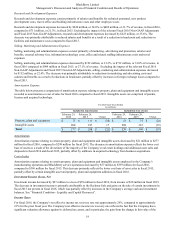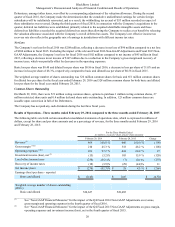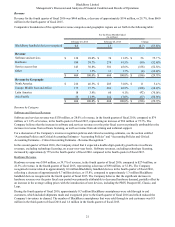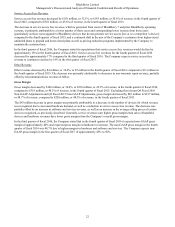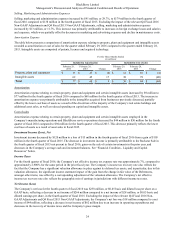Blackberry 2016 Annual Report Download - page 136
Download and view the complete annual report
Please find page 136 of the 2016 Blackberry annual report below. You can navigate through the pages in the report by either clicking on the pages listed below, or by using the keyword search tool below to find specific information within the annual report.BlackBerry Limited
Management’s Discussion and Analysis of Financial Condition and Results of Operations
28
Debenture Financing and Other Funding Sources
Please see Note 10 to the Consolidated Financial Statements for a description of the Debentures.
The Company has $44 million in collateralized outstanding letters of credit in support of certain leasing arrangements entered
into in the ordinary course of business. Please see Note 3 to the Consolidated Financial Statements for further information
concerning the Company’s restricted cash.
Cash, cash equivalents, and investments were approximately $2.6 billion as at February 29, 2016. The Company’s management
remains focused on maintaining appropriate cash balances, efficiently managing working capital balances and managing the
liquidity needs of the business. In addition, the Company continues to pursue opportunities to reallocate resources through the
RAP and to attain further cost savings in the coming fiscal quarters. Based on its current financial projections, the Company
believes its financial resources, together with expected future operating cash generating and operating expense reduction
activities and access to other potential financing arrangements, should be sufficient to meet funding requirements for current
financial commitments and future operating expenditures not yet committed, and should provide the necessary financial
capacity for the foreseeable future.
The Company does not have any off-balance sheet arrangements as defined in Item 303(a)(4)(ii) of Regulation S-K under the
Securities Exchange Act of 1934, as amended, or under applicable Canadian securities laws.
Legal Proceedings
The Company is involved in litigation in the normal course of its business, both as a defendant and as a plaintiff. Management
reviews all of the relevant facts for each claim and applies judgment in evaluating the likelihood and, if applicable, the amount
of any potential loss. Where a potential loss is considered probable and the amount is reasonably estimable, provisions for loss
are made based on management’s assessment of the likely outcome. Where a range of loss can be reasonably estimated with no
best estimate in the range, the Company records the minimum amount in the range. The Company does not provide for claims
for which the outcome is not determinable or claims for which the amount of the loss cannot be reasonably estimated. Any
settlements or awards under such claims are provided for when reasonably determinable.
As of February 29, 2016, there are no claims outstanding for which the Company has assessed the potential loss as both
probable to result and reasonably estimable, therefore no accrual has been made. Please see Note 14 (Commitments and
Contingencies) to the Consolidated Financial Statements for a further discussion of the Company’s legal matters.
Market Risk of Financial Instruments
The Company is engaged in operating and financing activities that generate risk in three primary areas:
Foreign Exchange
The Company is exposed to foreign exchange risk as a result of transactions in currencies other than its functional currency, the
U.S. dollar. The majority of the Company’s revenues in fiscal 2016 were transacted in U.S. dollars. Portions of the revenues
were denominated in Canadian dollars, Euros and British pounds. Purchases of raw materials are primarily transacted in U.S.
dollars. Other expenses, consisting mainly of salaries, certain operating costs and manufacturing overhead are incurred
primarily in Canadian dollars, but were also incurred in U.S dollars, Euros and British pounds. At February 29, 2016,
approximately 10% of cash and cash equivalents, 30% of accounts receivables and 16% of accounts payable were denominated
in foreign currencies (February 28, 2015 – 26%, 30% and 13%, respectively). These foreign currencies primarily include the
Canadian dollar, Euro and British pound. As part of its risk management strategy, the Company maintains net monetary asset
and/or liability balances in foreign currencies and engages in foreign currency hedging activities using derivative financial
instruments, including currency forward contracts and currency options. The Company does not use derivative instruments for
speculative purposes. Please see Note 5 to the Consolidated Financial Statements for information concerning the Company’s
foreign currency hedging activities.
Interest Rate
Cash and cash equivalents and investments are invested in certain instruments of varying maturities. Consequently, the
Company is exposed to interest rate risk as a result of holding investments of varying maturities. The fair value of investments,
as well as the investment income derived from the investment portfolio, will fluctuate with changes in prevailing interest rates.
The Company has also issued the Debentures with a fixed interest rate. The fair value of the Debentures will fluctuate with
changes in prevailing interest rates. Consequently, the Company is exposed to interest rate risk as a result of the long term of
the Debentures. The Company does not currently utilize interest rate derivative instruments to hedge its investment portfolio.



